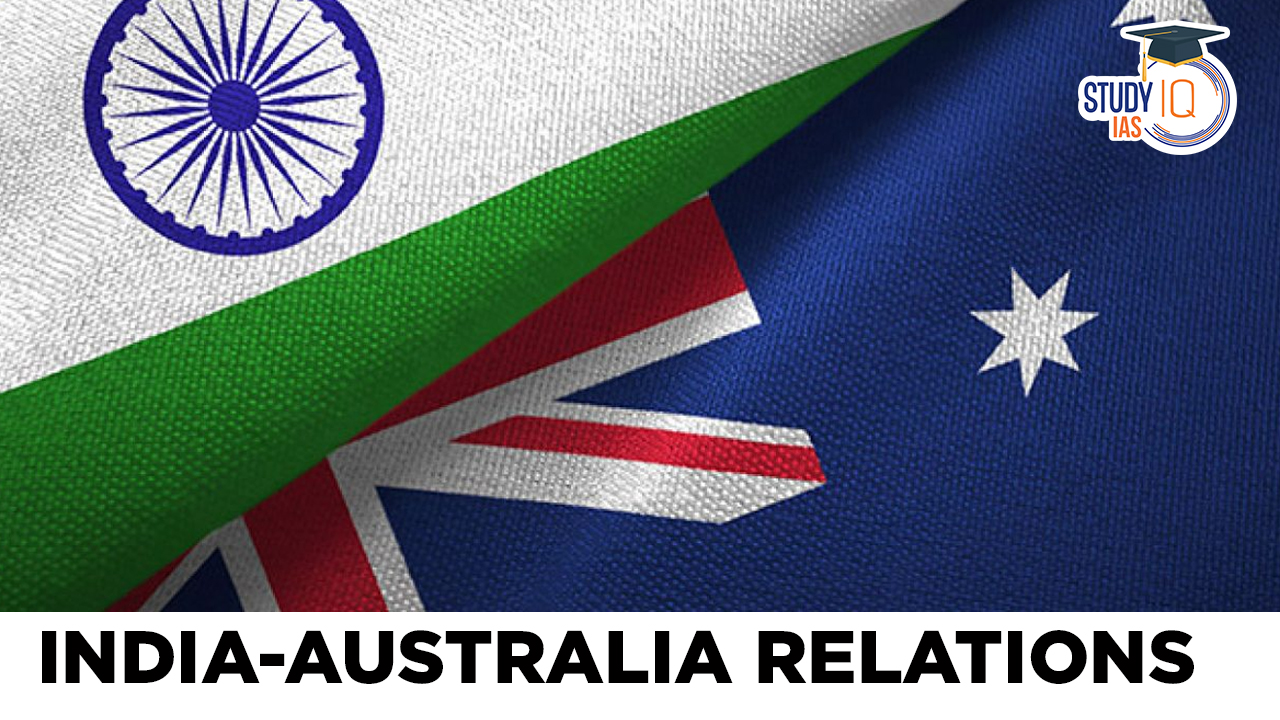Table of Contents
Context: The Indian Prime Minister will be visiting Australia despite the cancellation of the Quad Summit meeting in Sydney.
More on the News
- This demonstrates the significance that Delhi places on the bilateral relationship with Australia.
- Over the past decade, the India-Australia relationship has experienced a remarkable transformation, characterized by increasing cooperation and mutual understanding.
- The upcoming meeting presents an opportunity to transform the “watershed moment for bilateral relations” between both the nations.
Anticipated Significance of the Meet
- Multilateral Engagements: The frequency of interactions between the leaders of Australia and India has increased in recent times, taking place on the sidelines of various multilateral, trilateral, or minilateral forums such as the G7, the East Asia Summit, the G20, and the Indian Ocean Rim Association.
- The Quad, a forum focused on ensuring peace and prosperity in the Indo-Pacific region, holds particular importance for both nations.
- Key regional issues such as maritime domain awareness, supply chain resilience, climate change, and food and energy security drive the discussions within the Quad framework.
- Strategic Relationship: Australia and India have committed to building secure and resilient supply chains in sectors such as clean energy, electric vehicles, semiconductors, aerospace, and defence, all of which hold strategic importance for Quad members.
- The recent Memorandum of Understanding signed between India’s Khanij Bidesh Ltd (KABIL) and Australia’s Critical Minerals Office further supports these commitments.
- Space collaboration: Space is another significant area highlighted in the Australia-India bilateral partnership, with Australia participating as a partner country in the Bengaluru Space Expo and supporting India’s Gaganyaan Space Programme.
- The newly launched Australia-India-focused International Space Investment grants program aims to foster collaboration in the space sector.
- Education: Education remains a crucial pillar of the bilateral relationship, with Australia being a popular destination for Indian students.
- The issues of student mobility, visa backlogs, and future research collaboration will hold center stage during the bilateral meeting.
- The recent announcement of an education agreement for the mutual recognition of qualifications between the two countries demonstrates a comprehensive commitment unmatched by any other country.
- Trade and Investment: Both nations can deepen their ties by setting clear targets to significantly increase the current trading partnership above $35 billion by 2030 and establish a timeline for a Comprehensive Economic Cooperation Trade Agreement.
- Cultural Links: Australia has also taken steps to strengthen its friendship, trust, and commitment to India. It is set to open a new consulate in Bengaluru, India’s tech capital, and launch a center for Australia-India relations in Sydney to enhance cultural linkages.
- These initiatives demonstrate Australia’s resolve to foster a strong partnership with India as a counterweight to the uncertain dynamics in the region caused by China’s non-rules-based approach.
India-Australia Relations
- India and Australia have several commonalities which serve as a foundation for closer cooperation and multifaceted interaction, on lines similar to what India has developed with other Western countries.
- India and Australia, both are strong, vibrant, secular and multicultural democracies.
- The English language, cricket and large number of Indian students going to Australia for education are significant elements in the bilateral relations.
- The establishment of diplomatic relations between them dates back to the Pre-independence era with the opening of the Consulate General of India as a Trade Office in Sydney in 1941.
- After the Indian economic reforms, the relationship has grown in strength and expanded to areas such as trade, energy and mining, science & technology, information technology and defence.

Current Areas of Cooperation
- Political:
- In 2009, the relationship was upgraded to a “Strategic Partnership.”
- Both countries cooperate in multiple multilateral forums and Australia supports India’s bid for an expanded UN Security Council seat.
- They are members of various organizations such as the G-20, Commonwealth, IORA, ASEAN Regional Forum, and East Asia Summits.
- Australia supports India’s membership in APEC and became an Observer in SAARC in 2008.
- Mutual Legal Assistance Treaty (MLAT) and Extradition Treaty were signed between the two countries in June 2008.
- The first “2+2 Dialogue” between the foreign secretaries and defence secretaries of both countries took place in 2017.
- Economic:
- The Australian government released the India Economic Strategy to 2035 in 2018 to strengthen the economic relationship with India and tap into its economic growth potential.
- Bilateral trade between India and Australia amounted to A$26.24 billion in FY 2019-20, with India being the 8th largest trade partner of Australia.
- India exported goods worth A$7.59 billion to Australia, including refined petroleum, medicaments, pearls, gems, and textiles.
- Australia’s imports from India, valued at A$18.65 billion, included coal, copper ores, natural gas, and education-related services.
- Education is Australia’s largest service export to India, valued at $6 billion in 2020, accounting for a significant portion of the total service exports.
- The Treasury-NITI Aayog Economic Policy Dialogue commenced in 2019 when a delegation led by the CEO of NITI Aayog visited Australia, marking the first such dialogue.
- To facilitate more business partnerships between Australia and India, the Australian Government launched the Australia India Business Exchange (AIBX) program, offering services to support Australian businesses entering the Indian market, providing industry-specific insights, guidance on doing business in India, and entering the online retail sector.
- Both countries are currently in discussions for a Comprehensive Economic Cooperation Agreement (CECA) aimed at granting Indian exporters greater market access for goods and services in Australia.
- Cultural Ties:
- There are almost 496,000 people of Indian origin living in Australia, and they play important roles as teachers, doctors, accountants, engineers, and researchers, contributing to the Australian economy.
- India is the third largest source of immigrants for Australia.
- The relationship between India and Australia is based on three key elements: cricket, curry (referring to Indian cuisine), and the Commonwealth (referring to their shared membership in the Commonwealth of Nations).
- Nuclear Engagements:
- In 2012, the Australian Government decided to supply uranium to India.
- A Civil Nuclear Cooperation Agreement was signed between the two countries in 2014 to establish a framework for significant new energy trade between Australia and India.
- To support this agreement, the Australian Parliament passed the “Civil Nuclear Transfer to India Bill 2016.” This bill ensures that Australian uranium mining companies can fulfill contracts to supply uranium to India for peaceful purposes.
- Defence Ties:
- Australia and India have a strong defence relationship, supported by the 2006 Memorandum on Defence Cooperation and the 2009 Joint Declaration on Security Cooperation.
- Australia took part in Exercise MILAN 2014, hosted by India, which provided an opportunity for collaboration with India and other regional navies.
- In 2014, both countries established a Framework for Security Cooperation that includes various actions such as high-level dialogue, expanding defence dialogues and joint exercises, exploring joint defence production, and collaborating on counter-terrorism efforts.
- India and Australia committed to holding the AUSINDEX bilateral naval exercise biennially.
- Exercise Pitch Black is a warfare exercise held every two years and hosted by the Royal Australian Air Force (RAAF).
- Additionally, both countries collaborate in the AUSTRAHIND exercise, which involves special forces from their respective armies.
- Agriculture:
- Australia and India established the Australia-India Strategic Research Fund (AISRF) to support collaborative research projects.
- The AISRF focuses on various areas such as agricultural research, astronomy and astrophysics, environmental sciences, microelectronics, nanotechnology, renewable energy, marine sciences, and earth systems sciences.
- Both governments have invested over $100 million in the AISRF. Joint Committees on Science and Technology (S&T) and Biotechnology have been created to manage the fund.
- Australia is also involved in cooperating with India’s Clean Ganga Project.
- Energy Ties:
- In 1999, a Joint Working Group on Energy and Minerals was created to strengthen the relationship between Australia and India in the energy and resources sector.
- Indian companies such as Adani Enterprises, GVK Power and Infrastructure, and NMDC are actively exploring opportunities for mineral exploration in Australia.
- In 2017, Australia signed a framework agreement to join the International Solar Alliance, led by the Governments of India and France.
- The Australia-India Energy Dialogue serves as the main platform for discussing bilateral engagement in energy and resources.
- During the recent QUAD summit, both sides agreed to establish a partnership for low emissions technology. This partnership will concentrate on hydrogen development and ultra-low-cost solar programs to support India’s transition to clean energy.
Challenges in India-Australia Relations
- Different concerns regarding China: Australia is concerned about China’s increased activities in the Pacific, while India is worried about China’s growing presence and influence in the Indian Ocean. These different concerns can affect the alignment of interests and strategies between the two countries.
- Lack of trust: Despite notable development in strategic and defence engagement, there is a lack of sufficient strategic trust between India and Australia. This is evident in India’s decision to exclude the Australian Navy from the trilateral ‘Malabar’ naval exercises, indicating a need for greater trust-building efforts.
- Narrow trade base: Trade between India and Australia is limited, with around 70% of Australian exports to India comprising only two items – coal and gold. There is a need to diversify and expand the trade relationship to encompass a broader range of goods and services.
- Australia’s ‘457 Visa’ issue: Australia’s reforms to the temporary foreign worker program, particularly the requirement for applicants to be permanent residents for a longer period and embrace “Australian values,” have caused concern in India. This affects India’s demand for labour mobility and can impact the future movement of skilled workers between the two countries.
- Nuclear deal complexities: Despite the signing of a civil nuclear cooperation agreement, there are reservations among many in Australia regarding the export of uranium to India. Australia’s policy of supplying uranium only to countries that have signed the Nuclear Non-Proliferation Treaty poses a challenge as India has not signed the treaty.


 Libya
Libya
 India’s Reliance on China for Critical...
India’s Reliance on China for Critical...




















